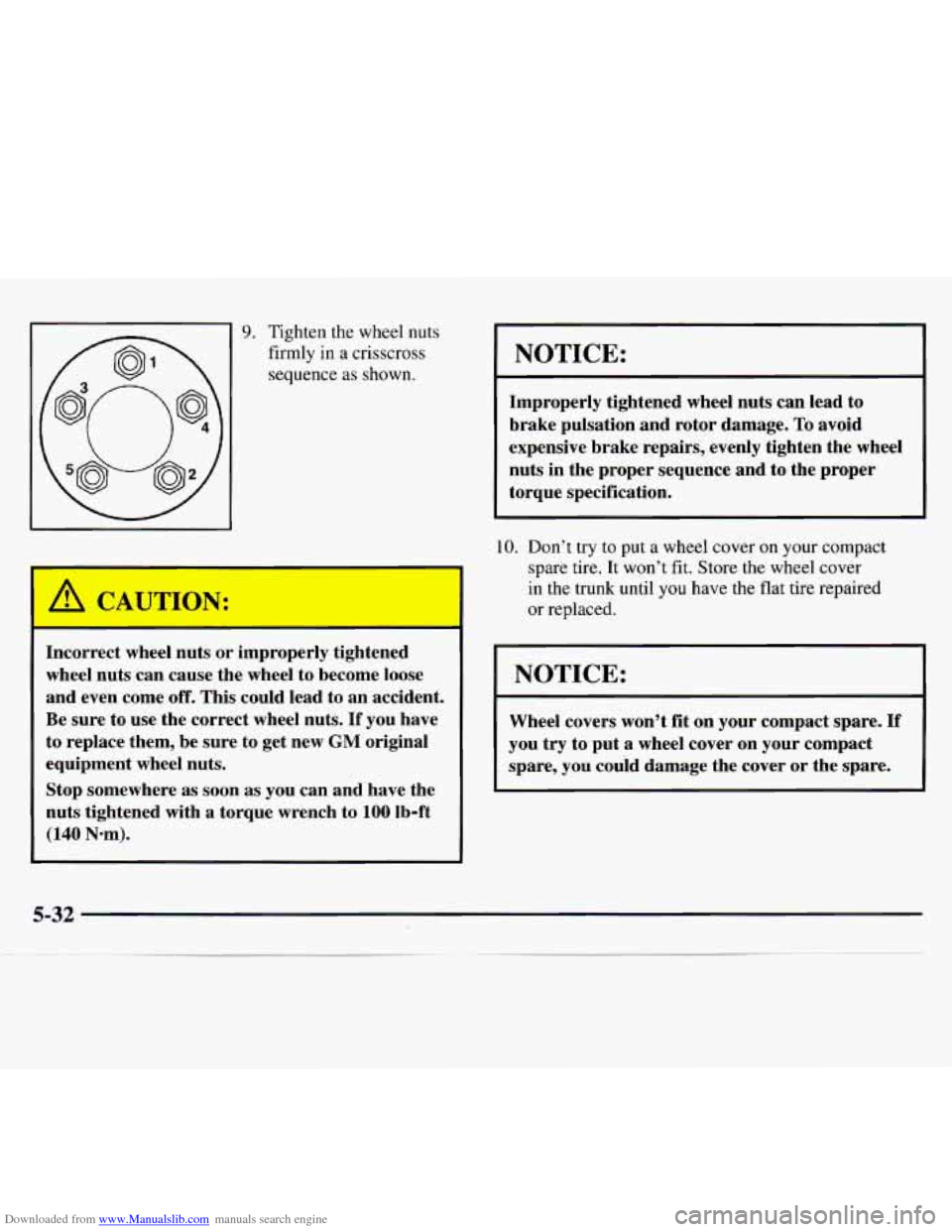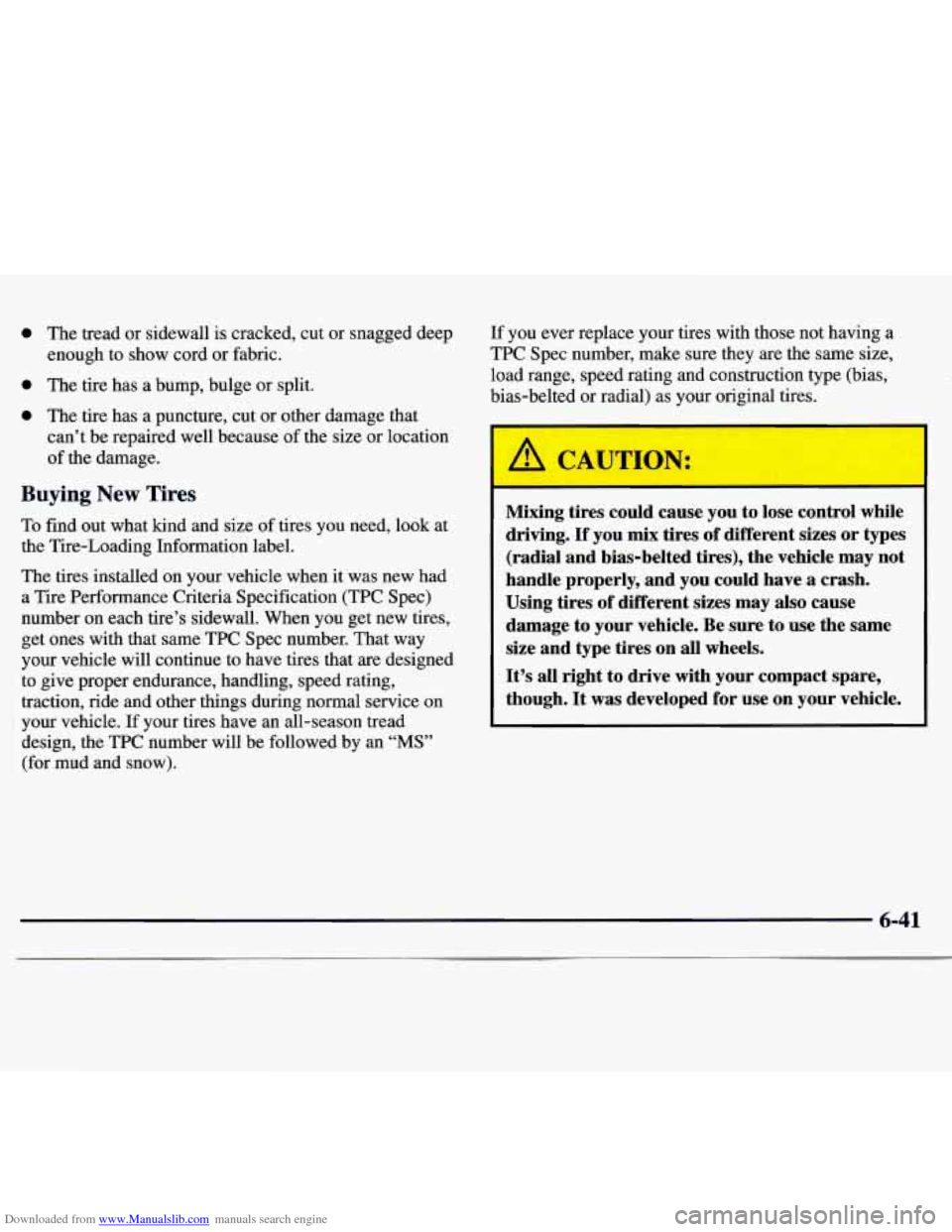Page 205 of 358
Downloaded from www.Manualslib.com manuals search engine Removing the Flat Tire and Installing the
Spare Tire
1. Using the wheel wrench, loosen all the wheel nuts.
Don't remove them yet.
2. Turn the jack handle clockwise to raise the jack lift
head a few inches.
3. Position the jack under
the vehicle and raise the
jack lift head until it fits
firmly into
the notch in
the vehicle's frame
nearest the flat tire.
Put the compact
spare
tire near you.
A CAUTION:
Getting under a vehicle when it is jacked up is I
dangerous. If the vehicle slips off the jack, you !
could be badly injured or killed. Never get under i
a vehicle when it is supported only by a jack.
Page 206 of 358
Downloaded from www.Manualslib.com manuals search engine A CAUTION:
Raising your vehicle with the jack improperly
positioned can damage the vehicle and even make
the vehicle fall.
To help avoid personal injury
and vehicle damage, be sure to fit the jack lift
head into the proper location before raising
the vehicle.
4.
Raise the vehicle by turning the jack handle
clockwise. Raise
the vehicle far enough off the
ground for
the spare tire to fit under the vehicle.
5. Remove all wheel nuts and take off the flat tire.
Page 207 of 358
Downloaded from www.Manualslib.com manuals search engine 6. Remove any rust or dirt
from the wheel bolts,
mounting surfaces and
spare wheel.
A CAUTION:
Rust or dirt on the wheel, or on the parts to
which it
is fastened, can make the wheel nuts
become loose after
a time. The wheel could come
off and cause an accident. When you change a
wheel, remove any rust or dirt from the places
where the wheel attaches to the vehicle. In an
emergency, you can use a cloth or a paper towel
to do this; but be sure to use a scraper or wire
brush later, if you need to,
to get all the rust or
dirt off.
I A CAUTION:
Never use oil or grease on studs or nuts. If you
do, the nuts might come loose. Your wheel. could
fall off, causing a serious accident.
1
Page 209 of 358

Downloaded from www.Manualslib.com manuals search engine 9. Tighten the wheel nuts
firmly in a crisscross
sequence as shown.
r
Incorrect wheel nuts or improperly tightened
wheel nuts can cause the wheel to become loose
and even come
off. This could lead to an accident.
Be sure to use the correct wheel nuts.
If you have
to replace them, be sure to get new
GM original
equipment wheel nuts.
Stop somewhere as soon
as you can and have the
nuts tightened
with a torque wrench to 100 Ib-ft
(140 Nom).
~ NOTICE:
Improperly tightened wheel nuts can lead to
brake pulsation and rotor damage.
To avoid
expensive brake repairs, evenly tighten the wheel
nuts in the proper sequence and to the proper
torque specification.
10. Don’t try to put a wheel cover on your compact
spare tire.
It won’t fit. Store the wheel cover
in the trunk until you have the flat tire repaired
or replaced.
I NOTICE:
Wheel covers won’t fit on your compact spare. If
you try to put a wheel cover on your compact
spare, you could damage the cover or the spare.
1
5-32
Page 210 of 358

Downloaded from www.Manualslib.com manuals search engine Storing the Flat Tire and Tools
1
I A CAUTION: I
Storing a jack, a tire or other equipment in the
passenger compartment
of the vehicle could
cause injury. In a sudden stop or collision, loose
equipment could strike someone. Store all these
in the proper place.
After you’ve put the compact spare tire on your vehicle
you’ll need to store the flat tire in your trunk. Use the
following procedure to secure the flat tire in the trunk.
Put the flat tire in the trunk
so the side that faces out
when it is on the vehicle is facing down. The full-size
tire will
not fit down into the well. Place it so the front is
in the well and the rear
is out of the well. Put the bolt through
one of the wheel nut holes, install
the retainer over the bolt, then install the wing
nut. Put
the spacer and
nut next to the tire in the well. Store the
cover
as far forward as possible.
The compact spare is for temporary use only. Replace
the compact spare tire with a full-size tire as
soon as you
can. See “Compact Spare”
in the Index. See the storage
instructions label to replace your compact spare into
your trunk properly.
When you install the wheel cover on the full size tire,
tighten the nut caps
to 5 lb-ft (7 N-m).
Page 212 of 358

Downloaded from www.Manualslib.com manuals search engine Compact Spare Tire
Although the compact spare tire was fully inflated when
your vehicle was new, it can lose air after a time. Check
the inflation pressure regularly. It should be
60 psi
(420 Wa).
After installing the compact spare on your vehicle,
you
should stop as soon as possible and make sure your spare
tire is correctly inflated. The compact spare is made to
perform well at speeds
up to 65 mph ( 105 km/h) for
distances up to
3,000 miles (5 000 km), so you can finish
your trip and have your full-size tire repaired or replaced
where
you want. Of course, it’s best to replace your
spare with a full-size tire as soon as you can. Your
spare will last longer and be in good shape in case you
need it again.
NOTICE:
When the compact spare is installed, don’t take
your vehicle through an automatic car wash with
guide rails. The compact spare can get caught on
the rails. That can damage the tire and wheel,
and maybe other parts
of your vehicle.
Don’t
use your compact spare on other vehicles.
And don’t mix your compact spare tire
or wheel with
other wheels or tires. They won’t fit. Keep your spare
tire and its wheel together.
NOTICE:
Tire chains won’t fit your compact spare. Using
them can damage your vehicle and can damage
the chains too. Don’t use tire chains on your
compact spare.
Page 254 of 358

Downloaded from www.Manualslib.com manuals search engine When to Check
Check your tires once a month or more.
Don’t forget your compact spare tire. It should be at
60 psi (420 kPa).
How to Check
Use a good quality pocket-type gage to check tire
pressure. You can’t tell
if your tires are properly inflated
simply by looking at them. Radial tires may look
properly inflated even when they’re underinflated.
Be sure to put
the valve caps back on the valve stems.
They help prevent leaks by keeping out dirt and moisture.
Tire Inspection and Rotation
Tires should be rotated every 6,000 to 8,000 miles
(10 OOO to 13 000 km). Any time you notice unusual wear,
rotate your tires as soon as
possible and check wheel
alignment.
Also check for damaged tires or wheels. See
“When It’s Time for New Tires” and “Wheel
Replacement” later in
this section for more information. The
purpose
of regular rotation is to achieve more
uniform wear
for all tires on the vehicle. The first
rotation
is the most important. See “Scheduled
Maintenance Services’’ in the Index for scheduled
rotation intervals.
When rotating your
tires, always use the correct rotation
pattern shown here.
Don’t include the compact spare tire in your
tire rotation.
Page 256 of 358

Downloaded from www.Manualslib.com manuals search engine 0 The tread or sidewall is cracked, cut or snagged deep
enough to show cord or fabric.
0 The tire has a bump, bulge or split.
0 The tire has a puncture, cut or other damage that
can’t be repaired well because of the size or location
of the damage.
Buying New Tires
To find out what kind and size of tires you need, look at
the Tire-Loading Information label.
The tires installed
on your vehicle when it was new had
a Tire Performance Criteria Specification (TPC Spec)
number on each tire’s sidewall. When you get new tires,
get ones with that same TPC Spec number. That way
your vehicle will continue to have tires that are designed
to give proper endurance, handling, speed rating,
traction, ride and other things during normal service
on
your vehicle. If your tires have an all-season tread
design, the TPC number will be followed by an
“MS”
(for mud and snow). If
you ever replace
your tires with those not having a
TPC Spec number, make sure they are the same size,
load range, speed rating and construction type (bias,
bias-belted or radial) as your original tires.
I
Mixing tires could cause you to lose control while
driving.
If you mix tires of different sizes or types
(radial and bias-belted tires), the vehicle may not
handle properly, and you could have a crash.
Using tires of different sizes may also cause
damage to your vehicle. Be sure to use the same
size and type tires on all wheels.
It’s all right to drive with your compact spare,
though. It was developed for use on your vehicle.
6-41